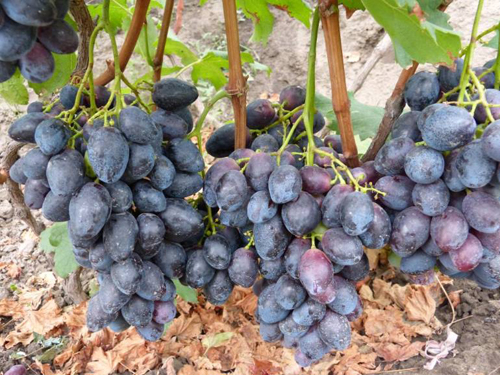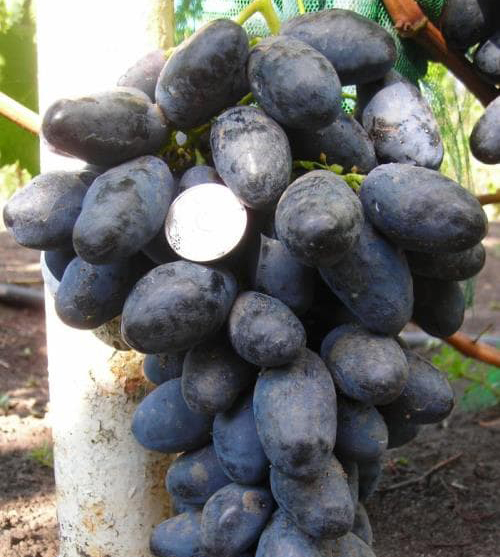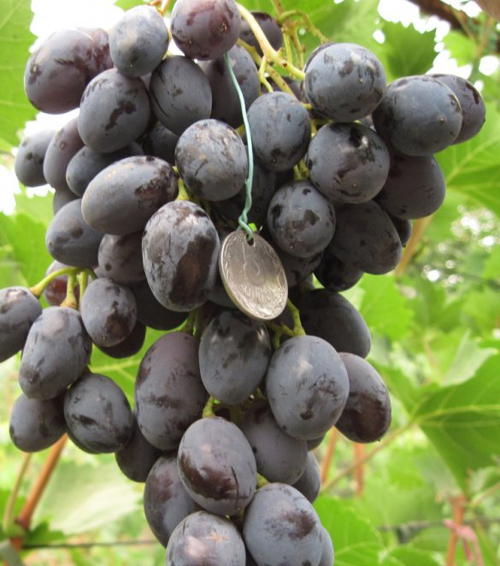Furor grape variety
Furor is an interesting new hybrid form of dark-colored table grapes, bred by Vasily Kapelyushny, a folk breeder from Rostov-on-Don. It appeared at the end of the 2000s and since then has been gradually gaining popularity among winegrowers who, in parallel, carry out its variety trials, clarifying the characteristics declared by the originator.
The author of the variety was not a scientist in the academic sense of the word. He began his career as a road maintenance engineer. He took up viticulture as an amateur in 1969 on his garden plot near the town of Aksai, Rostov region. Over the years, he studied more than a hundred varieties of the "sun berry", and in 1991 he organized and headed the peasant farm "Nadezhda", located on 12 hectares of the former state farm "Reconstructor". Horticulture and viticulture became the main activity of the new farm. Moreover, the latter direction was subsequently transformed from purely productive, first into nursery, and then into selection.

Research work with Vasily Ulyanovich is closely related to the acquaintance with the famous scientist-breeder from VNIIViV them. ME AND. Potapenko by Ivan Kostrikin. It was he who lit the spark of the researcher in Kapelyushny, clearly explaining that crossing grapes, especially varieties with functionally female flowers, is not difficult, and the prospects for such hybridization are truly endless. Thanks to the persistence and persuasiveness of Kostrikin, as well as under his sensitive methodological guidance, the future author of dozens of new hybrid forms got down to business, and, starting in 1995, actively engaged in amateur breeding. The results were not long in coming, and after a few years, promising hybrids were isolated from the offspring of the first crosses. By the middle of the 2000s, Vasily Ulyanovich already had 17 new forms to his credit, and the scale of breeding work reached an extraordinary level for an amateur. Hundreds of crosses were carried out annually, tens of thousands of hybrid seeds were obtained and sown, seedlings were grown and analyzed for the presence of economically valuable traits, and from a huge number of them, the units with the most successful characteristics were singled out.
This is how the Furor was born, originating from a variety of Ukrainian origin. Laura, fertilized with a mixture of pollen of the best varieties that were growing at that moment on the farm of Vasily Ulyanovich. The novelty after the first fruiting was noticed and noted by the author, but several more years passed until the grape seedling grew enough to provide vegetative material for propagation. Those growers who were lucky enough to be the first to acquire Furor on their plots confirm its high commercial and economic characteristics, and therefore there is no doubt that a great future and wide popularity await him.
Agrobiological characteristics
The bushes of the hybrid are vigorous. The crown of a young shoot is smooth, shiny, green in color with light reddish stripes on the axis and leaf petioles. Medium-sized leaf, elongated in length, has five lobes, but weakly dissected. The surface of the leaf blade is dark green, smooth, without pubescence on the dorsum. The upper side cutouts are shallow, open, slit-like, or in the shape of a recessed corner. The lower notches are barely visible or absent. The petiole notch can be of different types - both closed with a narrow elliptical or oval lumen, and open lyre-shaped with a rounded bottom. The petioles are long, graceful, with a noticeable anthocyanin tint. The teeth along the edge of the vine leaf are large, triangular with a wide base, convex edges and rounded tops.The flowers of the variety are bisexual, and therefore the hybrid is perfectly pollinated with its own pollen and does not show a tendency to pea berries and other flaws associated with insufficient fertilization. Annual vines ripen early and practically to their full length. The ripe shoot of Furora is colored yellowish-brown.

The bunches are large or very large, cylindrical-conical, of moderate density or loose, with an average weight of 900-1500 grams. Moreover, in terms of weight, individual copies even exceed these values. The grape's comb is long, branched, strong enough to withstand massive clusters, usually green in color, but often has a bright shade like leaf stalks. The berries are impressive in size, weight and evenness. The average length of a grape is 35-40 mm, the diameter in the wide part is 26-28 mm, the weight reaches 25-30 grams. The shape of the berries is oval or nipple, the color is dark purple, turning into black, the surface is covered with a dense protective waxy bloom of a gray color. The flesh is firm, but not coarse, juicy-fleshy, reddish-green in color. The taste is very sweet, pleasant and harmonious. The aroma has tones of nutmeg. The sugar content of the juice is remarkable for a table variety - 21-23 g / 100 ml, moderate acidity - 5-6 g / l. The skin is medium in thickness, quite firm, but edible. There are seeds, but they do not have a significant negative effect on the taste of large-caliber berries. Tasting grapes are deservedly high.
The harvest is excellent for fresh consumption. It is highly valued among farmers who cultivate it for commercial purposes for its excellent presentation, large-fruited and wonderful taste. In all respects, Furor is very "marketable", and appearing on the shelves, it exactly lives up to its name. The bunches have sufficient transportability, without losing their attractiveness even as a result of long-distance transportation. In addition, when assembled, they are well stored subject to the creation of optimal conditions for this - low positive temperatures and low relative humidity. The grapes are also suitable for processing. It produces juices, compotes, preserves and jams of exceptional taste, color and aroma. Good sugar content creates the preconditions even for processing the harvest of this variety into wine, but hardly anyone will raise a hand to crush such an attractive and tasty grape.
The hybrid is early maturing. Furora clusters gain the necessary condition and become ready to harvest within 105-110 days after the start of the growing season. During this period, plants require 2250-2350 ° C of the sum of active temperatures. This is enough to cultivate this variety in by no means the viticultural regions of the Russian Non-Black Earth Region up to the southern suburbs of Moscow. In Ukraine, he manages to ripen throughout the territory. In Belarus - with the exception of the northernmost regions. When cultivating in non-traditional areas, it is necessary to take into account the moderate indicators of frost resistance of the variety (-23 ... -24 ° C) and provide for the possibility of sheltering the bushes for the winter.

Furor from year to year shows a high and stable yield. The high vigor and vitality of the bushes, the considerable size of the bunches and a high fertility rate contribute to good productivity. Most of its shoots grow productive, and the average number of inflorescences laid on them is close to two. These circumstances are not only a reason for the grower to expect bountiful harvests, but also make one think about the need to regulate the load on plants. After all, no matter how much we want to get more grapes at once, first of all we need to think about the condition of the bushes themselves and their durability. By allowing regular overloads, we actually cut the goose that lays the golden eggs, because plants weakened by an excessive harvest have every chance of dying in a frosty winter. And the quality of grapes from an overloaded bush, as a rule, differs significantly for the worse in comparison with the standard.
Ripe bunches of this variety can continue to hang on the vine for several weeks without deterioration in marketability and taste. Having thus reached full ripeness, they will accumulate sugar even more, and the nutmeg aroma characteristic of the hybrid will manifest itself with greater force. At the same time, do not worry about the possible cracking of the berries or their damage by wasps. Experiencing Furor for several years, growers testify that the risk of such damage is minimal. Only in extreme drought is it worth leaving the ripe grapes on the bushes with caution, because with its continuation, the berries can become rainy, and with a sharp change with abundant rains, the "crackle" of grapes is still possible.
Agrotechnical features
Surprisingly, from an economic point of view, our hero is as good as from a gastronomic one. Its cultivation due to its relative unpretentiousness will not be difficult even for an inexperienced winegrower. So, for planting, it does not require special conditions, being able to grow on soils with different levels of fertility, moisture content and mechanical composition. This naturally does not mean that it does not react at all to the improvement of the agricultural background and can be planted anywhere. Like any other grape variety, it does not suit the cold slopes of the northern exposures, lowlands, wetlands, damp places, areas with high groundwater levels or excessively saline. Furor does not impose requirements for mandatory watering and regular feeding, but if they are available, it significantly increases an already decent yield. In the northern regions, where there is a risk of insufficient ripening of grapes, planting is carried out from the southern side of the walls of buildings, capital fences and other shelters from cold northern winds.
The resistance of the new hybrid to the root phylloxera is currently unknown, and therefore its planting in zones of soil contamination by this pest is possible only with seedlings grafted onto phylloxera-resistant rootstocks. The variety shows sufficient affinity with the most common of them, but it also takes root well on its own. Own-rooted culture is also possible, but only in regions free from phylloxera. The planting scheme is chosen based on local conditions: the level of mineral nutrition, moisture and heat supply, but in most cases it is necessary to give vigorous plants at least 4-4.5 sq. meters of food area.
In the south, judging by the frost resistance declared by the originator, Furor can be formed according to non-covering high-standard schemes, however, not possessing excessive credulity, most winegrowers still prefer to at least drop the vine into the ground for the winter. This takes away a lot of their energy, and, moreover, limits the possibilities of plants that they could demonstrate on standard formations with a large supply of perennial wood. Therefore, where the thermometer does not fall below -23 ° C in winter, it is recommended to take a closer look at the semi-covering schemes for maintaining a grape bush. In this case, its main part remains to winter on the trunk without shelter, and the reserve vine, formed in the form of a lightweight lower tier, is hiding, being a guarantee of the restoration of the damaged aerial part of the bush in case of insufficient frost resistance in this climate. In northern conditions, the vines of this variety are completely covered, for which the bushes are formed according to the traditional options in the covering zone - a multi-arm fan, Guyot or an inclined cordon. The material for insulation is chosen locally. It can be straw, peat, spruce branches, needle-bed, wood shavings, etc. The main rule is to arrange a waterproofing from a film, roofing material or wooden shields on top of the insulation so that the vine remains dry throughout the winter.
An obligatory set of measures during the cultivation of Furora is the limitation and careful regulation of its productivity. Without this, he is guaranteed to suffer from regular overloads, yield a mediocre harvest, and, in the end, may even die. The first operation in the process of rationing is spring pruning, in which about 30-40 buds are left on a bush of this variety with an average length of fruit arrows (6-8 eyes). After the buds have awakened and the shoots have begun to grow, it is necessary to carry out a fragment, during which sterile and weak vines are removed, on which nutrients are wasted without benefit. As a result, 20-24 strong fruitful shoots should remain on the plant, but they also need to remove excess inflorescences so that they remain one per shoot. Only in this case, load regulation can be considered complete, and up to 15-20 kilograms of conditioned grapes can be harvested from the bush. Naturally, these figures refer only to adult plants that have entered full fruiting. On young Furora bushes, the yield is limited even more.
In relation to fungal diseases, the variety behaves very dignified, demonstrating resistance to the main pathogens (mildew, oidium, gray rot) at a level above average. This allows you to abandon multiple spraying with chemical plant protection products, limiting yourself to several preventive treatments during the period of the highest harmfulness of pathogens - before and after the flowering of grapes. In the rest of the growing season, it is necessary to closely monitor the plants and point-wise to resist isolated outbreaks of diseases.
Good results are also shown by such agrotechnical measures as pinching and removing leaves in the fruit zone. Thanks to them, air exchange in the crown of the bush improves, the leaves and clusters dry out faster from the night dew, and the conditions for the development of pathogens generally deteriorate. Among other things, the best sun illumination of the bunches has a positive effect on the level of sugar accumulation, which, although not critically important for Furora, nevertheless, never hurts.








